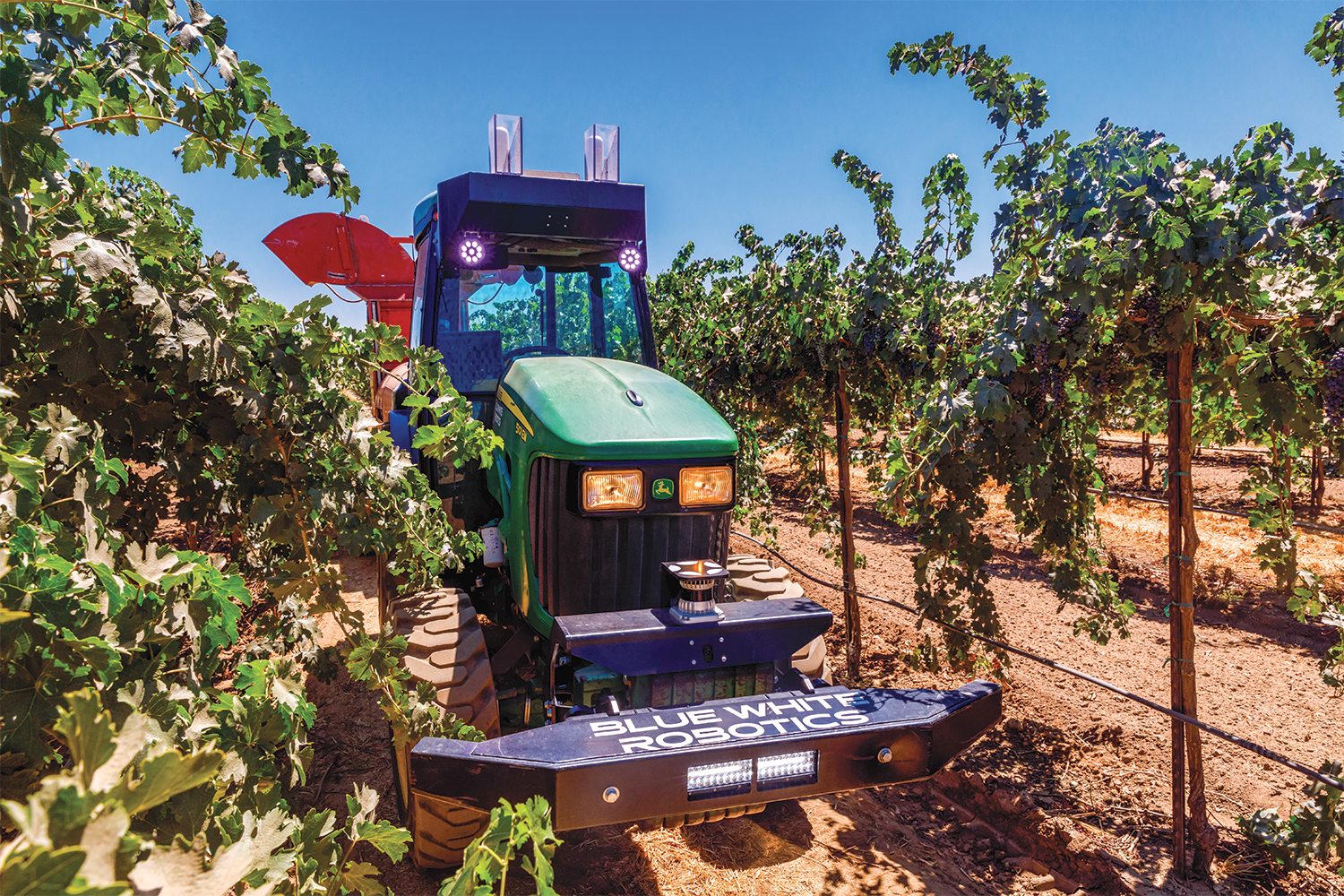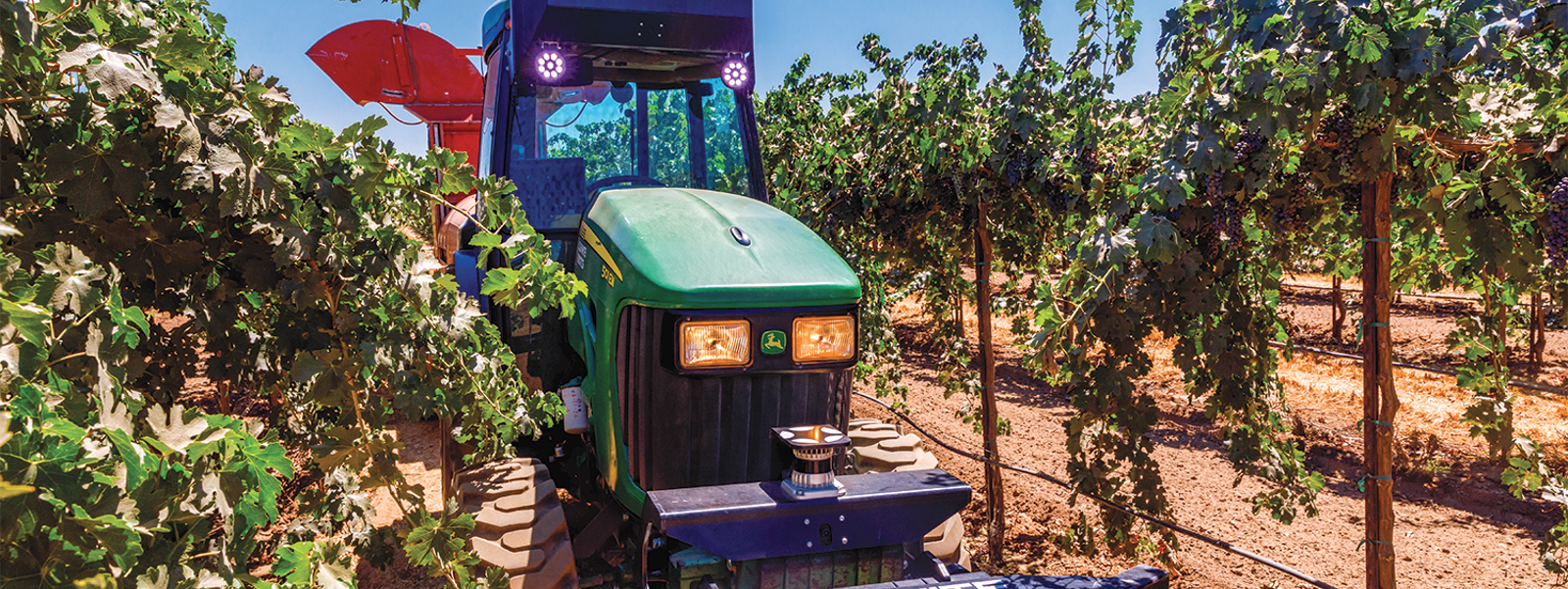Commentary: Advances for farms, workers blocked by a 1977 rule

An autonomous tractor that requires no driver on board is equipped to work in vineyards. But its use clashes with a ‘70s order requiring an operator at the vehicular controls.
Photo/Courtesy Blue White Robotics


By Bryan Little
California’s high concentration of tech inventors and engineers, venture capital firms and farmers are only beginning to imagine the ways autonomous technology can bring new efficiency to agriculture, continue improvements in farm safety and boost earnings. It’s the story of the last 500 years of human history, writ small in a California lettuce field or a strawberry patch.
Autonomous or remote-controlled tractors can perform many of the tasks that farmers use tractors for now, from towing an air-blast sprayer through an orchard to hauling bins of hand-harvested winegrapes from a vineyard to a winery. Yet, sadly, the prowess offered by driverless tractors is being blocked by state regulators under pressure from labor groups seeking to exploit antiquated rules to advance a false argument over saving jobs.
These technologies increase safety because they do not require a tractor driver, who normally would have to worry about protective clothing and a properly fitted respirator. Autonomous tractors or sprayers or weeders rely on GPS coordinates, visual recognition technology, laser-based detection of objects and obstacles, infrared sensors and other tech to guide them through rows of orchards or vineyards. Their visual detection technology can spot-check the health of trees and vines and precisely target a chemical application.
Autonomous weeders are already in use, employing visual recognition to separate newly sprouted lettuce from weeds and using lasers to burn weeds down to the root, removing the need for large crews of field workers wielding hoes or bending over seed beds to distinguish between sprouts and weeds.
This technology can be applied to assistive devices such as so-called mules, small electric vehicles that can follow a strawberry picker into a row and transport a full bin back to the end of the row to be checked in, examined for quality and recorded to ensure the picker receives appropriate credit when picking on a piece-rate. This spares the picker the physical burden of carrying each full bin to the end of the row, which adds rest and helps maximize earnings.
Yet the California Labor Federation and other purported advocates for workers assert that autonomous technology will eliminate jobs. Never mind that the California Employment Development Department tells us California has only about half as many tractor drivers as it needs. Labor unions and advocates also assert that such technology is dangerous to employees. Never mind that a driver is obviously safer when not even on the tractor.
The benefits of autonomy in agriculture are, unfortunately, being stymied by a nearly 50-year-old regulation dating to the groovy decade of the 1970s. General Industry Safety Order 3441(b) of 1977 was implemented to provide for safe operation of furrow-guided tractors creeping through fields at 2 miles per hour, not high-tech tractors or weeders.
The regulation requires that all “self-propelled equipment shall, when under its own power and in motion, have an operator stationed at the vehicular controls.”
The regulation describes detailed safety requirements for such tractors carrying harvesting platforms, seedling planters and other equipment that typically would have people working in close proximity. Steering controls are to be provided in an alternative location on the tractor if the tractor relies on furrow steering.
Yet autonomous and semi-autonomous vehicles had not been dreamed of when this regulation was written. They cannot comply with operator requirements of the 1977 order because they require no operator.
No other state or nation regulates autonomous agricultural vehicles—none but California, home of the Silicon Valley technology hub and America’s largest agricultural production state.
At its March meeting in Los Angeles, California Occupational Safety & Health Standards Board denied a request to even bring together stakeholders, including farmers, tech entrepreneurs, engineers and farm employee advocates, to begin talking about how autonomous technology can be deployed safely.
Empaneling such an advisory committee might result in regulatory proposals, which could be beneficial if all stakeholders reach a consensus around safe-use practices. My hope is that such a discussion could be productive, perhaps allowing for some exception to 1977 rules for advanced machinery or for setting minimum safety-practice standards for the use of such technology.
It’s truly unfortunate that so-called worker advocates adamantly oppose an advisory committee, taking a position that there is no way such technology can be safely used. They used their considerable influence before the Cal/OSHA standards board to ensure no conversations even occur to discuss how such technology can be properly deployed.
The California Farm Bureau and other organizations representing our state’s farmers and ranchers are ready to sit down with our labor and regulator counterparts to talk about how autonomous agricultural technologies can be used with appropriate safeguards. Preventing the progress—and safety—offered by these advancements is not the answer.
(Bryan Little is director of employment policy for California Farm Bureau and chief operating officer of Farm Employers Labor Service, or FELS. He may be contacted at blittle@cfbf.com.)




